Carelessness, complacency ... catastrophe
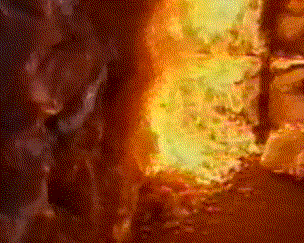
If you lost possessions in a fire at home your friends would think you were unlucky. If it happened again they might brand you careless, or even jinxed. And if it happened a third time....?
Fire destroys and fire kills. It very nearly brought Woolworth to its knees between 1979 and 1981.
This page is about incidents in Seventies and early Eighties that Woolworth did not want to remember, but some customers and firemen can never forget. We have included it in the Museum at the suggestion of some of the people who were there. We have tried to explain what happened honestly in the hope that it will make a difference. Please share your feedback.
Until the 1970s the chain had a reasonable safety record. With the exception of a V2 incident during World War II, while there had been several fires thankfully there had been virtually no serious injuries. Between 1909 and 1970 the company moved from small stores with wooden floors and mahogany counters, selling cheap everyday items, to huge multi-floor self-service superstores selling everything from quarters of sweets to three piece suites and from sink plugs to fitted kitchens. By 1970 the retail world had changed; while Woolworth's salesfloors had more or less kept up, behind the scenes little had changed for over fifty years. Initially this seemed quaint; on 8 May 1979 it turned out to be fatal.
1971 Warehouse fire at Castleton, Rochdale

At 4pm on Thursday 6 May 1971, four years after opening, the Woolworth Warehouse in Castleton, Rochdale caught fire. Staff raised the alarm, called the Fire Brigade and evacuated the building and the adjacent block of offices. A few employees attempted to tackle the blaze with fire hoses and extinguishers. At the time of the fire the site's sprinkler system was out of order. Despite this staff expected that, as the building was made of brick and concrete and was mainly stocked with tinned goods and soap powder, it would burn itself out.
The Fire Brigade arrived within minutes. The flames had already taken hold, with the roof, walls and stock ablaze and the building filled with acrid smoke. The firefighters summoned back-up and were soon joined by crews from across North West England. The flames could be seen from miles away. It took more than 100 officers to bring the inferno under control.

The Castleton campus housed a three chamber warehouse, which had formerly been an agricultural machinery depot, and the firm's main accounting office, computer room and mainframes. The two facilities stood close together, raising fears that the fire would spread to the office block. This led to frantic moves by members of the IT department to dismantle the mainframe computers piece-by-piece and pass the components through the windows to lorries outside. Others gathered boxes of punched cards and reels of magnetic tape for transport. At the time the firm had no back-up site, with all the stock records, accounts data and computer equipment held in the same location.
Television crews from BBC tv North West and Granada Reports captured events and relayed them live into homes across Northern England and into the national evening news. Reporters described the inferno and the frantic struggle behind the scenes to save the offices and equipment. The BBC camerman assigned to the incident later passed on his original footage to the North West Film Archive at Manchester Metropolitan University, who have preserved it.

After an epic struggle firefighters brought the flames under control. They saved two of the three distribution centre chambers and a little of the stock in them. The management offices were smokey but otherwise undamaged. The total loss was assessed to be £3m, which was the largest amount that had ever been claimed from an insurer in North West England. Fortunately no-one was hurt and the evacuation procedures at Castleton worked well, even if not the fire precautions. The cause was never established.
An enquiry into the incident criticised Woolworth for the faulty sprinkler system but commended the chain for installing a a 570,000 gallon water reservoir nicknamed 'the lodge' in the middle of the site. This had acted as a barrier between the depot and the offices, and had kept the hoses flowing until the fire was out.
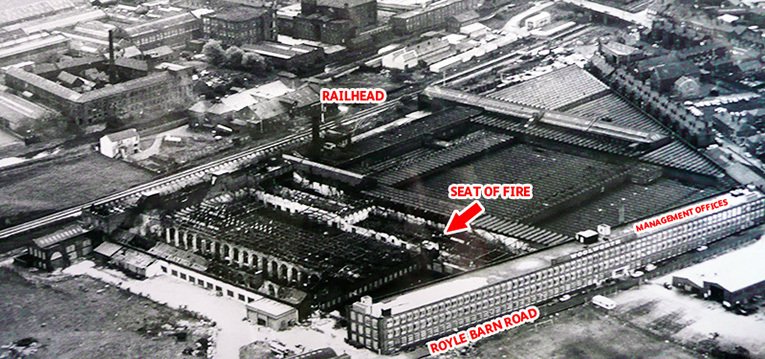
It was months before stock was fully back on the shelves in-store. Company bosses took the rebuilding as an opportunity to move away from rail transport onto lorry-based deliveries, progressively taking the purpose-built railhead out of use. Having seen the consequences of putting all of their eggs in one basket, they also speeded up the opening of a second Distribution Centre in Swindon, Wiltshire.
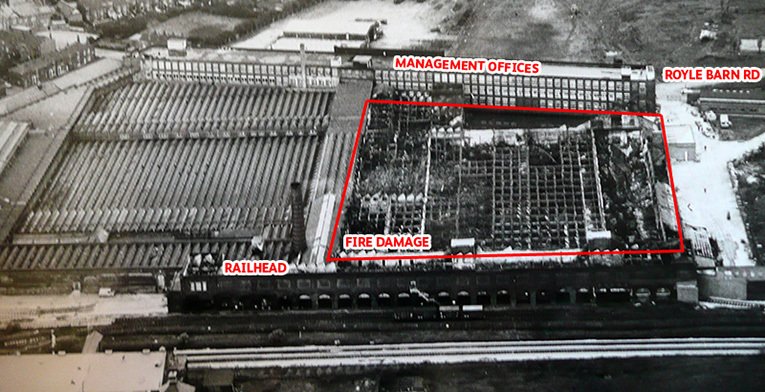
Civil disobedience in Belfast, Northern Ireland
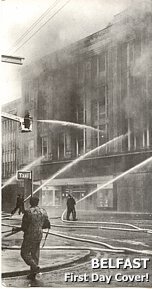
As the decade continued there were a number of major fires in Woolworth stores. The High Street, Belfast branch suffered a series of fires and bomb incidents, each causing substantial damage. City Centre shops were frequent targets during the Northern Ireland troubles. The authorities geared up for such incidents and provided extra training and procedures for the stores most at risk. It is tribute to the quality of the Northern Ireland Fire Service's prevention work that no-one was hurt in any of the Woolworth incidents. Each fire was quickly extinguished.
At the time the Northern Ireland Fire Service operated 210 appliances. They had 417 full-time personnel and 311 part-time and volunteer firefighters, and 55 fire stations. The picture of the Woolworth fire first appeared in the Belfast Telegraph. It was later chosen for a postage stamp which celebrated the achievements of the N.I.F.S. The first day cover is date-stamped on 24 April 1974.
This incident was one of 12,000 during the year. Less than one-sixth related to the troubles.
High Street Colchester Fire, Autumn 1973
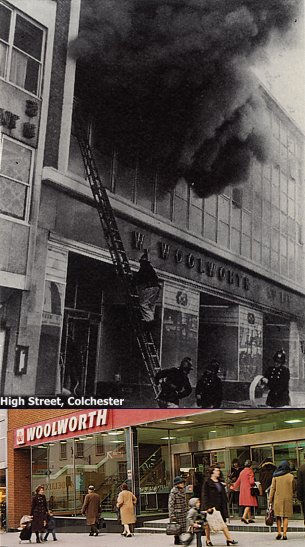
There were also a number of fires on the mainland. Several central London stores suffered minor damage that was never explained. Then, in Autumn 1973, the store at 40-50 High Street, Colchester, Essex burnt to the ground. A fire in the stockroom spread to the walls of the customer restaurant on the upper floor. Some customers refused to evacuate even when the flames became visible. One elderly lady insisted on finishing the pot of tea that she had paid for.
Reflecting today, little was learnt. Woolworth had no sprinklers, its procedures were archaic, and the incidents were not examined closely. It was the efficiency of the Fire Brigade that prevented loss of life rather than any preventitive measures taken. The focus was on reinstating the store, and indeed F.W. Woolworth & Co's 1976 Annual Report treated the affair as a positive:
A wonderful recovery in Colchester
The new Colchester store is an example of how quickly and positively we can react in an emergency situation.
A disastrous fire in the Autumn on 1973 completely destroyed the existing store in the High Street. Within just a month, a temporary store was opened in premises nearby. All staff were retained - if there was not space for a girl to keep her job in Colchester she was taken by the firm to work in a store elsewhere is East Anglia. Meanwhile the store was completely rebuilt and the new Colchester store opened on October 3rd 1975 with a gain of 2,500 square feet of selling space and a more comprehensive range of merchandise.
Right: the new store has extra selling space and an improved appearance.
Manchester 1979: the terrible cost of complacency
One of Woolworth's flagship stores stood on the corner of Manchester's Piccadilly and Oldham Street. The Founder had chosen a spot close by as the home for one of his first British stores in 1910. In the 1920s iconic purpose-built premises had been built, which were subsequently extended several times, before being fully modernised in 1972 to absorb trade from its sister store in St Mary's Gate, Deansgate which the Company had earmarked for closure. The upgrade had added a new salesfloor with a large restaurant, and space for new ranges of furniture, carpets, fitted kitchens and electrical appliances.
Company bosses were really proud of "4 Manchester", which served as the management training centre for all 250 branches in North West England and Ireland. Then one day the unthinkable happened. At lunchtime on 8 May 1979 a major broke out in the furniture department.
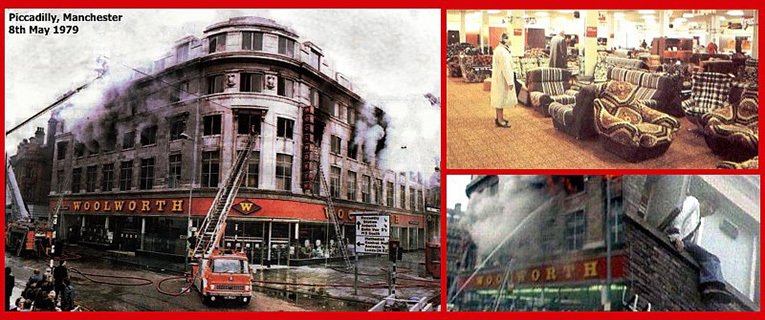
A passing taxi driver dialled 999 after seeing flames leap from an upper story window. Minutes later, when the engines arrived the top salesfloor was fully ablaze. Firefighters could see people trapped at barred windows in the staff area above the shop and on the roof. The Manager could not confirm that all of the customers had been evacuated.
It took more than three hours to bring the fire under control. BBC Radio Manchester's studios were next door, while BBC North West and Granada Television's studios were both both close by. The whole drama unfolded live on-air. The scenes were shocking and, to most observers, inexcusable. The Fire Brigade lost precious time cutting through the bars to release the trapped people. Worse still was that some exit doors had been locked shut to prevent shoplifters from slipping out without paying.
Nine customers and a member of staff died; many more suffered the effects of smoke and trauma. Some are still paying the price. Everyone at Woolworth was stunned. There were no easy answers.
The media coverage was clear. It described an utter failure of management, a poor building with feeble precautions and untrained staff, which had cost ten innocent people their lives. Customers had died while managers dithered.
THE FOLLOWING STATEMENT WAS MADE TODAY BY MR. STEPHEN OWEN, CHAIRMAN, F. W. WOOLWORTH & CO., LTD.
________________________________________________________________________________________________
On behalf of F. W. Woolworth and Co., Limited I wish to express deep sadness at the tragic consequences of the fire which broked out at Manchester Piccadilly store yesterday and convey our very sincere condolences to the relatives of those who lost their lives.
I would also like to express appreciation to our staff for coming so promptly to the assistance of customers; to the Manchester firemen for their fast, expert and courageous action in containing the scale of the tragedy; and to the police and hospital services for their devoted efforts.
This is an unprecedented disaster for the company and we shall do everything within our power to establish the cause of the fire. We shall make the findings available to others if it can help in any way to prevent such an accident recurring elsewhere. With the guidance of all available expertise we shall, of course, carry out a thorough and strict review of our already stringent safety controls to see if, in any way, they can be further improved.
END
___
9th May, 1979
A series of Inquiries revealed that there had been many deficiencies in the store's fire precautions. A mix-up meant that staff had not called the Fire Brigade as they should have done. The fire alarm had not sounded in the staff areas of the building. Some exit doors had been locked and others had 'break glass for key' arrangements, which had already been discredited in incidents elsewhere. But, in the final assessment, the cause of the deaths was a surprise.
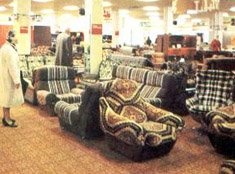
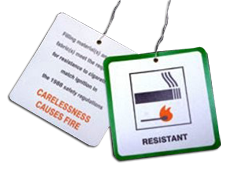
In the corner, out of sight, polyeurathane sofas had stood on their ends. The investigation concluded that their fabric had been set on fire, perhaps by a discarded cigarette. It had smouldered until the flames reached the foam filling. This was highly inflammable and had burnt at 700oC, releasing a deadly cyanide gas. A single breath had been enough to kill.
The style of budget seating was new; its low price had made it very popular in furniture stores across the land. The full dangers of the foam filling inside were not fully understood. It is possible that if Woolworth had installed modern smoke detection and automatic sprinklers, the fire might have been extinguished before the foam caught light. But, as the flames took hold, acrid smoke rose to the ceiling, obscuring the exits and giving people under a minute to get to a place of safety. For some this was not long enough. The Inquiry noted that the Fire Authority had not recommended improvements to the building when its fire certificate had been renewed. Sprinklers and smoke detectors were discretionary. It also noted that the locked doors had not directly contributed to the deaths at the store, and acknowledged that the management had co-operated fully with its investigation.
The Joint Fire Prevention Committee's Report prompted a number of actions by the Home Office. The laws on fire precautions, building design and safety certification, and the regulations governing furniture design were updated. Today these require that every piece of foam-filled furniture must have a fire retardant coating and must carry a warning label. Fire Officers believe that since the tragedy these have saved many deaths in house fires. But ten lives was a very high price to pay for the learning.
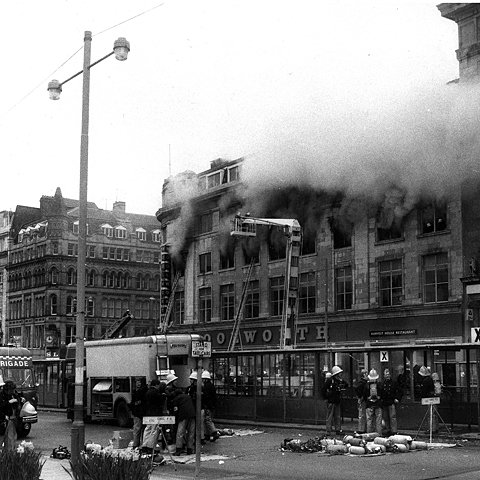
In memory of
Michael Archer (31)
Sarah Jane Bird (68)
Dorothy Botham (86)
Helena Gunn (69)
Hazel Ann Heaton (29) and Susan Heaton (32)
Albert Edward McNally (70)
Ernest Naylor (73)
Patricia Jean Simmonds (59)
And in honour of
Cyril Baldwin (68)
A Woolworth employee who had been an auxiliary fireman in World War II,
who gave his life in a valiant attempt to save them.
Without the exceptional courage and bravery of the Greater Manchester Fire Brigade the losses would have been far higher

Just one month after the tragic events in Manchester, in June 1979 the store in Worcester was severely damaged in a copycat arson attack, which started in foam filled pillows in the stockroom. No-one was hurt, but it took nine months to reinstate and re-open the store. When trading resumed the branch continued to carry a small range of foam filled furniture and pillows, albeit with very limited stocks and a state-of-the-art sprinkler and alarm system.
The Manchester store was reinstated at the expense of the insurer. It closed exactly five years later, the minimum time permitted in the circumstances. Many people believe that the takeover of Woolworth in 1982 was prompted by a loss of confidence in the management after the failures at Manchester. It took new owners to address many of the shortcomings identified and to train the staff properly.
Major fire destroys F.W. Woolworth in Wimbledon
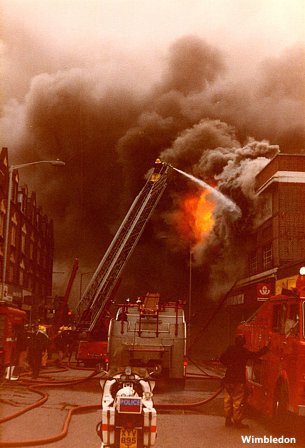
Only two years later, before the Manchester Inquiry Report, another large Woolworth's was destroyed, and tragically another young lfe was lost, this time in Wimbledon Broadway, South West London.
Better training meant that the premises were quickly evacuated after a small fire was discovered in the stockroom. But the building could not be saved.
Staff and customers looked on as Fire Bridgade professionals tackled the fire and appeared to bring it under control. Sadly in the aftermath, while damping down, three firemen became disoriented and were trapped as the building collapsed. One died while the other two were raced to hospital.
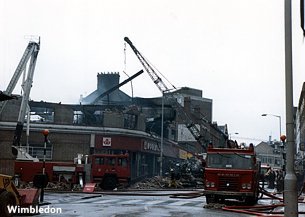
Left:The store after the incident. Only the ground floor brickwork remained intact.
Right: Two hours earlier as the fire raged.
Woolworth learnt a number of lessons from the tragedies at its stores in the 1970s and early 1980s. It became one of the leading outlets for smoke detectors. Its store managers worked closely with Fire Brigades around the country to promote the devices, while the company was instrumental in driving the price down from £20 each to £7 or less. Over the same period new regulations helped to improve the standards of safety in retail stores and health and safety more generally in the High Street. New Executives made safety a priority which was never compromised.
This page is dedicated to the commitment and bravery of Britain's firefighters who risk their lives to save others and occasionally, as in Wimbledon, pay the ultimate price. Our thoughts are with the families of the ten people who lost their lives at Manchester and the scores of customers and colleagues who were traumatised by these fires.
Shortcuts to related content
Decimalisation - counting the cost
The Wonder of Woolworth Commercials
View ads from the defining campaign
Brascan's hostile takeover bid in the USA
100 Years in Main Street USA and Canada
Site Navigation